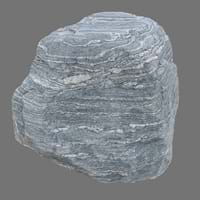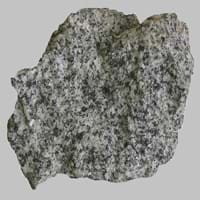Definition
Migmatite is typically a granitic rock within a metamorphic host rock which is composed of two intermingled but distinguishable components
Diorite is a grey to dark-grey intermediate intrusive igneous rock composed principally of plagioclase feldspar,biotite, hornblende, and pyroxene
Origin
Southern Alps, France
Unknown
Discoverer
Jakob Sederholm
Unknown
Etymology
From the Greek word migma which means a mixture
From early 19th century coined in French, formed irregularly from Greek diorizein distinguish
Class
Metamorphic Rocks
Igneous Rocks
Sub-Class
Durable Rock, Medium Hardness Rock
Durable Rock, Hard Rock
Group
Not Applicable
Plutonic
Other Categories
Coarse Grained Rock, Fine Grained Rock, Medium Grained Rock, Opaque Rock
Coarse Grained Rock, Medium Grained Rock, Opaque Rock
Texture
Foliated
Phaneritic
Color
Black, Bluish - Grey, Brown, Brown- Black, Dark Greenish - Grey, Dark Grey to Black
Black, Brown, Light to Dark Grey, White
Durability
Durable
Durable
Appearance
Dull, Banded and Foilated
Shiny
Interior Uses
Countertops, Flooring, Kitchens
Decorative Aggregates, Interior Decoration
Exterior Uses
As Building Stone, As Facing Stone
As Building Stone, As Facing Stone, Garden Decoration
Other Architectural Uses
Curbing
Curbing
Construction Industry
As Dimension Stone, Cement Manufacture, for Road Aggregate, Making natural cement
As Dimension Stone, Cement Manufacture, Cobblestones, Construction Aggregate, for Road Aggregate
Medical Industry
Not Yet Used
Not Yet Used
Antiquity Uses
Artifacts
Artifacts, Monuments, Sculpture, Small Figurines
Commercial Uses
Cemetery Markers, Jewelry, Tombstones, Used to manufracture paperweights and bookends
Creating Artwork, Curling
Types
Diatexites and Metatexites
Not Available
Features
Generally rough to touch, Is one of the oldest rock
Typically speckled black and white.
Archaeological Significance
Monuments
Not Yet Used
Used
Famous Monuments
Not Applicable
Data Not Available
Sculpture
Not Yet Used
Used
Famous Sculptures
Not Applicable
Data Not Available
Pictographs
Used
Not Used
Petroglyphs
Used
Not Used
Figurines
Not Yet Used
Used
Formation
Migmatites form by high temperature regional and thermal metamorphism of protolith rocks where rocks melt partially due to high temperature.
Diorite is a coarse-grained intrusive igneous rock which contains large interlocking and randomly oriented crystals and forms when molten lava does not reach the Earth’s surface and cools down in the Earth’s crust.
Mineral Content
Biotite, Chlorite, Feldspar, Garnet, Graphite, Hornblade, Micas, Muscovite or Illite, Quartz, Quartzite, Silica, Zircon
Albite, Amphibole, Apatite, Biotite, Feldspar, Hornblade, Ilmenite, Magnetite, Muscovite or Illite, Olivine, Plagioclase, Pyroxene, Quartz, Sulfides, Titanite, Zircon
Compound Content
Aluminium Oxide, NaCl, CaO, Carbon Dioxide, Iron(III) Oxide, FeO, Potassium Oxide, Magnesium Carbonate, MgO, MnO, Phosphorus Pentoxide, Silicon Dioxide, Titanium Dioxide
Silicon Dioxide
Types of Metamorphism
Burial Metamorphism, Cataclastic Metamorphism, Regional Metamorphism
Cataclastic Metamorphism, Contact Metamorphism, Regional Metamorphism
Types of Weathering
Biological Weathering, Chemical Weathering, Mechanical Weathering
Biological Weathering, Chemical Weathering, Mechanical Weathering
Types of Erosion
Chemical Erosion, Glacier Erosion, Water Erosion, Wind Erosion
Chemical Erosion, Coastal Erosion, Water Erosion
Grain Size
Medium to Fine Coarse Grained
Medium to Coarse Grained
Fracture
Irregular
Not Available
Streak
White
Bluish Black
Porosity
Very Less Porous
Very Less Porous
Luster
Dull to Pearly to Subvitreous
Shiny
Compressive Strength
Not Available
Cleavage
Poor
Not Available
Specific Gravity
2.65-2.75
2.8-3
Transparency
Opaque
Opaque
Density
Not Available
2.8-3 g/cm3
Resistance
Heat Resistant, Pressure Resistant
Heat Resistant, Pressure Resistant, Wear Resistant
Deposits in Eastern Continents
Asia
China, India, Iran, Iraq, Kazakhstan, Kyrgyzstan, Mongolia, Russia
Not Yet Found
Africa
Cameroon, Ethiopia, Ghana, Kenya, Madagascar, Morocco, Mozambique, Namibia, Nigeria, Tanzania, Togo
Egypt
Europe
Albania, Austria, Bosnia and Herzegovina, Finland, France, Georgia, Germany, Hungary, Italy, Kosovo, Monaco, Norway, Poland, Romania, Serbia, Slovakia, Slovenia, Sweden, Switzerland, Ukraine, United Kingdom
Finland, Germany, Italy, Romania, Sweden, Turkey, United Kingdom
Others
Not Yet Found
Not Yet Found
Deposits in Western Continents
North America
Canada, Costa Rica, Cuba, Mexico, Panama, USA
USA
South America
Argentina, Bolivia, Brazil, Chile, Colombia, Ecuador, Peru, Venezuela
Argentina, Bolivia, Chile, Colombia, Ecuador, Peru
Deposits in Oceania Continent
Australia
New South Wales, New Zealand, Queensland, Victoria
New Zealand, Western Australia










